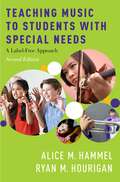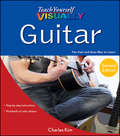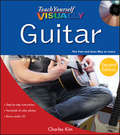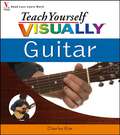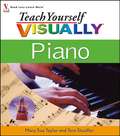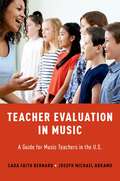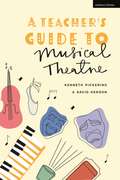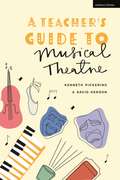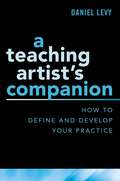- Table View
- List View
TCL020963e Clarinet 2023 Grade 5 piano score & part
by VariousPlease note: MP3 audio files exist on RNIB Bookshare that accompany this title. Please email bookshare@rnib.bookshare to request them quoting the ISBN number.
TCL020970e Clarinet 2023 Grade 6 piano score & part
by VariousPlease note: MP3 audio files exist on RNIB Bookshare that accompany this title. Please email bookshare@rnib.bookshare to request them quoting the ISBN number.
TCL020994e Clarinet 2023 Grade 8 piano score & part
by VariousPlease note: MP3 audio files exist on RNIB Bookshare that accompany this title. Please email bookshare@rnib.bookshare to request them quoting the ISBN number.
TCL023911e Theory Past Paper 2018 May A (Spanish) - Grade 8
by Trinity College London PressTCL023911e Theory Past Paper 2018 May A (Spanish) - Grade 8
TCL023928e Theory Past Paper 2019 May A (Spanish) - Grade 1
by Trinity College London PressTCL023928e Theory Past Paper 2019 May A (Spanish) - Grade 1
TCL023935e Theory Past Paper 2019 May A (Spanish) - Grade 2
by Trinity College London PressTCL023935e Theory Past Paper 2019 May A (Spanish) - Grade 2
TCL023942e Theory Past Paper 2019 May A (Spanish) - Grade 3
by Trinity College London PressTCL023942e Theory Past Paper 2019 May A (Spanish) - Grade 3
TCL023959e Theory Past Paper 2019 May A (Spanish) - Grade 4
by Trinity College London PressTCL023959e Theory Past Paper 2019 May A (Spanish) - Grade 4
TCL023966e Theory Past Paper 2019 May A (Spanish) - Grade 5
by Trinity College London PressTCL023966e Theory Past Paper 2019 May A (Spanish) - Grade 5
TCL023973e Theory Past Paper 2019 May A (Spanish) - Grade 6
by Trinity College London PressTCL023973e Theory Past Paper 2019 May A (Spanish) - Grade 6
TCL023980e Theory Past Paper 2019 May A (Spanish) - Grade 7
by Trinity College London PressTCL023980e Theory Past Paper 2019 May A (Spanish) - Grade 7
TCL024084e Theory Past Paper 2019 May A (Spanish) AMusTCL
by Trinity College London PressTCL024084e Theory Past Paper 2019 May A (Spanish) AMusTCL
TEACH MUSIC STUD W/ SPECIAL NEEDS 2E C: A Label-Free Approach
by Alice M. Hammel Ryan M. HouriganThe Second Edition of Teaching Music to Students with Special Needs offers updated accounts of music educators' experiences, featured as vignettes throughout the book. An accompanying Practical Resource includes lesson plans, worksheets, and games for classroom use. As a practical guide and reference manual, Teaching Music to Students with Special Needs, Second Edition addresses special needs in the broadest possible sense to equip teachers with proven, research-based curricular strategies that are grounded in both best practice and current special education law. Chapters address the full range of topics and issues music educators face, including parental involvement, student anxiety, field trips and performances, and assessment strategies. The book concludes with an updated list of resources, building upon the First Edition's recommendations.
Teach Yourself VISUALLY Guitar (Teach Yourself VISUALLY Consumer #54)
by Charles KimEverything beginners need to know to start playing guitar Do you learn faster by seeing and doing than by wading through tedious instructions? Then pick up a guitar and start strumming! Teach Yourself VISUALLY Guitar shows you the basics—step by step and note by note. You begin with basic chords and techniques and progress through suspensions, bass runs, hammer-ons, and barre chords. As you learn to read tablature and lead sheets, you can play any number of songs and styles of music, from rock to folk to country. The chord chart and scale appendices are ready references for use long after you master the basics. Plus, this new edition includes an audio CD so you can hear what each note, chord, and technique should sound like, along with a new chapter on reading music. This new edition includes substantial improvements to get readers playing the guitar faster A photo-intensive, step-by-step approach to playing acoustic and electric guitar The bonus CD includes more than 100 audio tracks Whether you've never picked up a guitar or want to brush up on the basics, Teach Yourself VISUALLY Guitar will get you strumming in no time.
Teach Yourself VISUALLY Guitar (Teach Yourself VISUALLY Consumer #34)
by Charles KimEverything beginners need to know to start playing guitar Do you learn faster by seeing and doing than by wading through tedious instructions? Then pick up a guitar and start strumming! Teach Yourself VISUALLY Guitar shows you the basics—step by step and note by note. You begin with basic chords and techniques and progress through suspensions, bass runs, hammer-ons, and barre chords. As you learn to read tablature and lead sheets, you can play any number of songs and styles of music, from rock to folk to country. The chord chart and scale appendices are ready references for use long after you master the basics. Plus, this new edition includes an audio CD so you can hear what each note, chord, and technique should sound like, along with a new chapter on reading music. This new edition includes substantial improvements to get readers playing the guitar faster A photo-intensive, step-by-step approach to playing acoustic and electric guitar The bonus CD includes more than 100 audio tracks Whether you've never picked up a guitar or want to brush up on the basics, Teach Yourself VISUALLY Guitar will get you strumming in no time.
Teach Yourself VISUALLY Guitar
by Charles KimDo you learn faster by seeing and doing than by wading through tedious instructions? Then pick up a guitar and start strumming! Teach Yourself VISUALLY Guitar shows you the basics—photo by photo and note by note. You begin with basic chords and techniques and progress through suspensions, bass runs, hammer-ons, and barre chords. As you learn to read chord charts, tablature, and lead sheets, you can play any number of songs, from rock to folk to country. The chord chart and scale appendices are ready references for use long after you master the basics. Concise two-page lessons show you all the steps to a skill and are ideal for quick review Each skill, chord, or technique is clearly described Detailed color photos demonstrate proper fingering and technique Concise and understandable instructions accompany each photo Helpful tips provide additional guidance
Teach Yourself VISUALLY Piano
by Mary Sue Taylor Tere Stouffer DrenthWant to go beyond "Chopsticks?" This visual guide to tickling the ivories will show you the way. By Chapter 2, you'll be playing simple pieces and practicing scales. You'll progress from getting familiar with notes, symbols, and keys to playing basic chords and reading music like a pro. Without getting bogged down in boring theory, you'll learn what you need to know and enjoy playing as you go! Whether you like Bach or rock, jazz or country, golden oldies or new age, you'll love learning to play the fun, visual way. Concise two-page lessons show you all the crucial skills and are ideal for quick review Each skill, chord, or technique is clearly described Concise and understandable instructions accompany each photo Detailed color photos demonstrate proper fingering technique Helpful tips provide additional guidance
Teacher Evaluation in Music: A Guide for Music Teachers in the U.S.
by Cara Faith Bernard Joseph Michael AbramoTeacher Evaluation in Music: A Guide for Music Teachers in the U. S. aims to help music teachers navigate the controversial terrain of teacher evaluation. Rather than entering the debate on policy divorced from practice, this book is intended as a pragmatic approach to help music teachers to thrive within teacher evaluation systems and as a way to improve practice. Using Shulman's concept of content knowledge, general pedagogical knowledge, and pedagogical content knowledge, this book strives to help music teachers find a balance between advocating for themselves and their programs and for using teacher evaluation to improve their teaching. The book covers history of policy and law of teacher evaluation and the competing uses of teacher evaluation to rate teachers or as a professional development tool. The descriptions of policies, laws, and competing uses are approached in a way to help music teachers use teacher evaluation for their benefit to grow as professionals. This book has chapters devoted to giving detailed and specific strategies in key areas that research has suggested music teachers struggle to implement: questioning, literacy, differentiated instruction, and assessment. Complimenting these key areas are sample lesson plans which apply the strategies of questioning, differentiation, literacy, and assessment discussed in each chapter. These lessons serve as a resource and guide for teachers to develop their own lessons and improve their practice. The final chapter gives guidance on how music teachers may talk to administrators and evaluators to make teacher evaluation productive. Through these detailed descriptions of understanding teacher evaluation, talking to evaluators, and improving practice, music teachers may not just survive but thrive in these systems of accountability.
TEACHER EVALUATION IN MUSIC C: A Guide for Music Teachers in the U.S.
by Cara Faith Bernard Joseph Michael AbramoTeacher Evaluation in Music: A Guide for Music Teachers in the U. S. aims to help music teachers navigate the controversial terrain of teacher evaluation. Rather than entering the debate on policy divorced from practice, this book is intended as a pragmatic approach to help music teachers to thrive within teacher evaluation systems and as a way to improve practice. Using Shulman's concept of content knowledge, general pedagogical knowledge, and pedagogical content knowledge, this book strives to help music teachers find a balance between advocating for themselves and their programs and for using teacher evaluation to improve their teaching. The book covers history of policy and law of teacher evaluation and the competing uses of teacher evaluation to rate teachers or as a professional development tool. The descriptions of policies, laws, and competing uses are approached in a way to help music teachers use teacher evaluation for their benefit to grow as professionals. This book has chapters devoted to giving detailed and specific strategies in key areas that research has suggested music teachers struggle to implement: questioning, literacy, differentiated instruction, and assessment. Complimenting these key areas are sample lesson plans which apply the strategies of questioning, differentiation, literacy, and assessment discussed in each chapter. These lessons serve as a resource and guide for teachers to develop their own lessons and improve their practice. The final chapter gives guidance on how music teachers may talk to administrators and evaluators to make teacher evaluation productive. Through these detailed descriptions of understanding teacher evaluation, talking to evaluators, and improving practice, music teachers may not just survive but thrive in these systems of accountability.
A Teacher’s Guide to Musical Theatre
by Kenneth Pickering David HensonAre you a teacher of musical theatre who struggles to plan and construct lessons? Are you looking for a structured approach to teaching musical theatre to students of all abilities? Do you know your Ivor Novello from your Stephen Sondheim? Despite being one of the most popular forms of performance study, Musical Theatre is often the most difficult to teach due to its part-practical and part-academic approach. With few books on the market directly aimed at teachers, it can be a challenging and daunting task to devise a course of study that takes in the history of the form as well as considering the wider aspects that come together to make a successful musical. A Teacher's Guide to Musical Theatre enables teachers to plan and deliver courses in Musical Theatre with confidence and flair. The unique structure of the chapters guides teachers through key facts and concepts in musical theatre history and offers practical in-class activities for students. From topics for class discussion and essay assignments to journal entries and portfolios to sample test questions, this book is full of practical advice from experienced teachers in the field which make it the idea companion for teachers and instructors on diploma and degree-level courses, as well as those devising courses in part-time performing arts schools. Devised to provide sufficient engaging and inspirational material for an initial term or semester, the book establishes the principles of teaching this relatively new subject and encourages teachers to extend much further into the subject. From The Mikado to Hamilton and everything in between, this book breaks down decades of history into appropriately sized lessons, designed to give students a rounded survey of the subject and an understanding of how musicals work. Offering expert guidance to those with varied fields of expertise and practical experience but limited teaching experience, this book is the only existing guide to structured and stimulating practice.
A Teacher’s Guide to Musical Theatre
by Kenneth Pickering David HensonAre you a teacher of musical theatre who struggles to plan and construct lessons? Are you looking for a structured approach to teaching musical theatre to students of all abilities? Do you know your Ivor Novello from your Stephen Sondheim? Despite being one of the most popular forms of performance study, Musical Theatre is often the most difficult to teach due to its part-practical and part-academic approach. With few books on the market directly aimed at teachers, it can be a challenging and daunting task to devise a course of study that takes in the history of the form as well as considering the wider aspects that come together to make a successful musical. A Teacher's Guide to Musical Theatre enables teachers to plan and deliver courses in Musical Theatre with confidence and flair. The unique structure of the chapters guides teachers through key facts and concepts in musical theatre history and offers practical in-class activities for students. From topics for class discussion and essay assignments to journal entries and portfolios to sample test questions, this book is full of practical advice from experienced teachers in the field which make it the idea companion for teachers and instructors on diploma and degree-level courses, as well as those devising courses in part-time performing arts schools. Devised to provide sufficient engaging and inspirational material for an initial term or semester, the book establishes the principles of teaching this relatively new subject and encourages teachers to extend much further into the subject. From The Mikado to Hamilton and everything in between, this book breaks down decades of history into appropriately sized lessons, designed to give students a rounded survey of the subject and an understanding of how musicals work. Offering expert guidance to those with varied fields of expertise and practical experience but limited teaching experience, this book is the only existing guide to structured and stimulating practice.
A Teaching Artist's Companion: How to Define and Develop Your Practice
by Daniel LevyYou are an artist, living the artist's life. But you also want to make a difference in the world as a teaching artist. You know how to pursue excellence in your art form; how can you pursue excellence in teaching artistry? A Teaching Artist's Companion: How to Define and Develop Your Practice is a how-to reference for veteran and beginning teaching artists alike. Artist-educator Daniel Levy has been working in classrooms, homeless shelters and correctional facilities for over thirty years. With humor and hard-won insight, Levy and a variety of contributing teaching artists narrate their successes and failures while focusing on the practical mechanics of working within conditions of limited time and resources. Levy organizes teaching artist practice within a framework of View, Design, and Respond. View is everything you value and believe about teaching and learning; Design is what you plan before you go into a classroom; Respond is how you react to and support your students face to face. With the aid of checklists, worksheets, and primary sources, A Teaching Artist's Companion invites you to define your own unique view, and guides your observing, critiquing, and shaping your practice over time.

